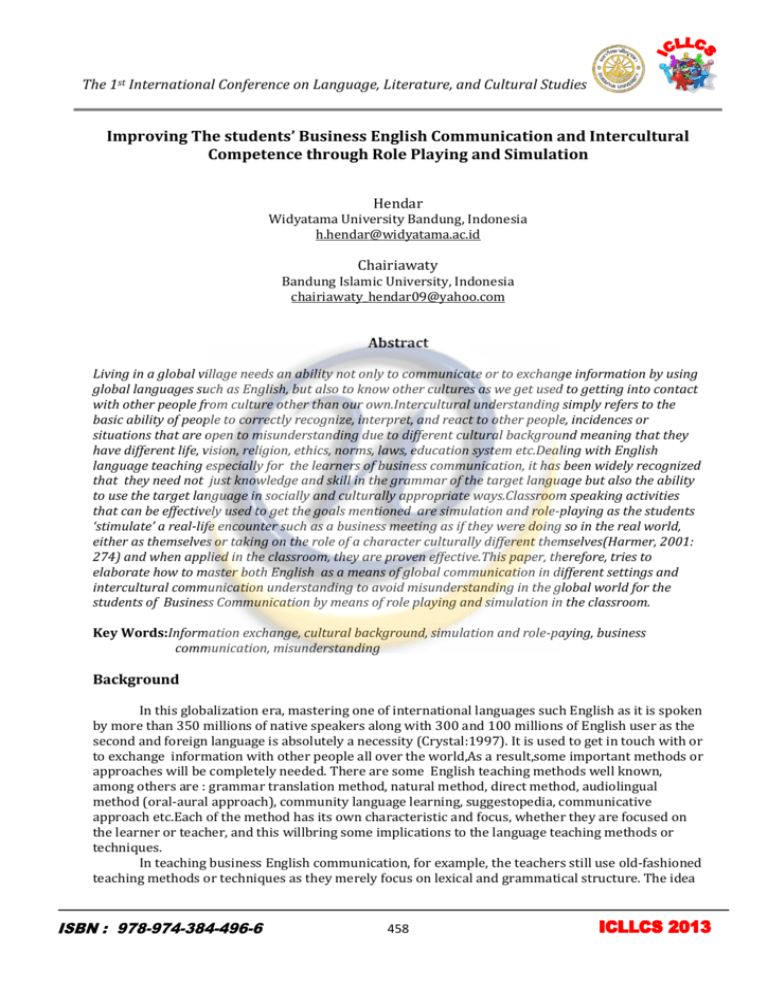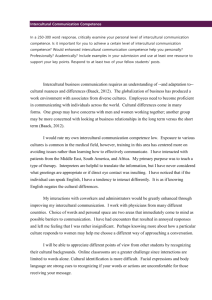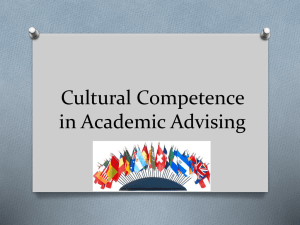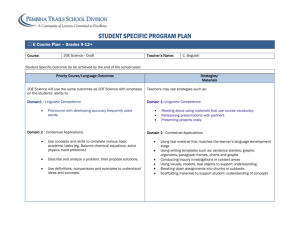
The 1st International Conference on Language, Literature, and Cultural Studies
Improving The students’ Business English Communication and Intercultural
Competence through Role Playing and Simulation
Hendar
Widyatama University Bandung, Indonesia
h.hendar@widyatama.ac.id
Chairiawaty
Bandung Islamic University, Indonesia
chairiawaty_hendar09@yahoo.com
Abstract
Living in a global village needs an ability not only to communicate or to exchange information by using
global languages such as English, but also to know other cultures as we get used to getting into contact
with other people from culture other than our own.Intercultural understanding simply refers to the
basic ability of people to correctly recognize, interpret, and react to other people, incidences or
situations that are open to misunderstanding due to different cultural background meaning that they
have different life, vision, religion, ethics, norms, laws, education system etc.Dealing with English
language teaching especially for the learners of business communication, it has been widely recognized
that they need not just knowledge and skill in the grammar of the target language but also the ability
to use the target language in socially and culturally appropriate ways.Classroom speaking activities
that can be effectively used to get the goals mentioned are simulation and role-playing as the students
‘stimulate’ a real-life encounter such as a business meeting as if they were doing so in the real world,
either as themselves or taking on the role of a character culturally different themselves(Harmer, 2001:
274) and when applied in the classroom, they are proven effective.This paper, therefore, tries to
elaborate how to master both English as a means of global communication in different settings and
intercultural communication understanding to avoid misunderstanding in the global world for the
students of Business Communication by means of role playing and simulation in the classroom.
Key Words:Information exchange, cultural background, simulation and role-paying, business
communication, misunderstanding
Background
In this globalization era, mastering one of international languages such English as it is spoken
by more than 350 millions of native speakers along with 300 and 100 millions of English user as the
second and foreign language is absolutely a necessity (Crystal:1997). It is used to get in touch with or
to exchange information with other people all over the world,As a result,some important methods or
approaches will be completely needed. There are some English teaching methods well known,
among others are : grammar translation method, natural method, direct method, audiolingual
method (oral-aural approach), community language learning, suggestopedia, communicative
approach etc.Each of the method has its own characteristic and focus, whether they are focused on
the learner or teacher, and this willbring some implications to the language teaching methods or
techniques.
In teaching business English communication, for example, the teachers still use old-fashioned
teaching methods or techniques as they merely focus on lexical and grammatical structure. The idea
458
The 1st International Conference on Language, Literature, and Cultural Studies
was that students should use language in controlled exercises until they have mastered its structure
to high degree, and only then begin to talk freely.
In Indonesia, business English communication course is an integral part of the curriculum of
business and management and the aims of the Business English course are as follows:
To develop students reading, speaking, listening and writing skills in Business English in order
for the students to understand a range of work- or business-related information and respond
appropriately when required.
To develop students’ Business communication skills such as meeting, presentation, negotiation in
order for the students to be able to interact in a range of work-or business communication.
To familiarize students with basic business concepts in order for the students to be able to
communicate effectively in international working environment.
To achieve the goals above, the teachers are supposed not to teach it by using old-fashioned
teaching methods or techniques only focusing on lexical and grammatical structure. Besides,
nowadays it is generally believed that the mastery of a language is more than that of a set of
grammatical rules with attendant sets of vocabulary to be memorized. It is a dynamic resource for
creating meaning. The teachers of business English Communication, therefore, should emphasize the
importance of fostering students’ ability to communicate in the foreign language rather than their
skill in constructing correct sentences and improving communicative skills engaging students in
learner-centered activities such as simulation and role playing has to become one of the most
important components of the teaching process.
The Objective of The Research
The aim of the small qualitative research is to find out whether or not role playing and
simulation are the effective teaching techniques in both improving the students’ English business
communication and their intercultural competence.
The Method of The Research
The method used in this research is a descriptive qualitative method as it tries to describe
the effectiveness of role playing and simulation as English teaching techniques to improve the
students’ English business communication and their intercultural competence primarily based on
the data obtained from the library study, observation and interview given to the English teacher
who teach Business English Communication and 24students majoring in Business and Management
especially who are taking Business English Communication. The procedure of how to get data
needed for this research are as follows:
a. The researcher directly observed the classroom activity. He was provided by the log book to write
down every activity taken place, such as what the teacher designed for the class activities by
means of role playing and simulation, what the students did during the class meeting, how the
students took part in the class activities, what the teacher’s role was, how the classroom activity
went on,how the students behaved, how students used their language and how the teacher did
evaluation dealing with class activities, teaching techniques used, students’ participation in each
activity, the weakness and the strength of the students in using language functions and of their
intercultural competence..
b. Researcher also used his opportunity to interview the teacher especially relating to the
development of students’ interest and development after they were given the simulation and role
playing techniques.
c. Researcher also interviewed the students about what they could achieve and what they expected
from their experience of taking different roles in any different culture and how they conducted
self assessment in terms of their English language and their intercultural competence.
459
The 1st International Conference on Language, Literature, and Cultural Studies
Literature Review
a. language and culture
Language as a means of communication whether it is verbal or non verbal, written or spoken
cannot be apart from culture as it provides a means of encoding a community’s knowledge beliefs
and values, i.e. its culture (Holmes, 2001:329) besides the language one uses expresses what he
knows, he feels, and he believes. In other words, the ability of using a foreign language must be in
line with that of understanding the culture where the language is used as Brembeck says, “To know
another’s language and not his culture is very good way to make a fluent fool of one’s self.”
Levine (1993:84) stated that in language, there are unspoken rules of speaking and they exist
in every language but differ significantly from culture to culture. These rules have to do with
permissible degrees of directness, politeness and formality and they affect many of functions of
communication. In a small talk, for example, before leading to interesting conversation or discussion,
in America, people usually begin to ask appropriate questions for their initial small talk such as
“How long have you lived here?”, “Do you like living here”?, “What do you do?”, “What are you studying?
(to a student)” or “ What do you think of weather we’ve been having?” and they will not begin their
initial small talk by asking inappropriate questions such as “Are you married?”, “How much money do
you earn?” How much did you pay for your car?”, What is your religion?”, or “Are you a Republican or a
Democrat?” (Levine, 1993:85) even though they are still common in some countries especially
Indonesia. Therefore, culture always influence the language used, in whatever the areas are: social,
politics, even business.
In a business world, the use of language appropriate with the culture involved is very important in
order to avoid a misunderstanding or misperception that might make a business transaction failed.
Therefore the mastery of intercultural competence is so essential that it will sometimes influence on
the failure or success of our business. Samovar (2004:304)explains that to interact with an Arab, you
should know his or her values regarding gender, hospitality, pride, honor, and rivalry. You should
also know that Islam is a regulator of behavior as well as a religion and that Arab males engage in a
very direct eye contact. You should even learn about the Arabic language because your
communication with Arab will improve if you know that or if you were going to Japan, you might
benefit from advice about gift giving, the use of first names, greeting behavior, indirect speech,
politeness, the use of business card, the importance of group harmony, social stability, the use of
“yes” and “no” and the like (Mc Daniels, 2000: 312-324).
From the explanation above, it can be concluded that language and culture are interrelated,
and language cannot be taught without culture. Therefore, the more business English students know
language and its culture, the better they will be working in international environment.
b. Intercultural competence
According to Barrett,M. et.al (2013:10), Intercultural competence is a combination of
attitudes, knowledge, understanding and skills applied through action which enables one, either
singly or together with others, to:
understand and respect people who are perceived to have different cultural affiliations from
oneself
respond appropriately, effectively and respectfully when interacting and communicating with
such people
establish positive and constructive relationships with such people
understand oneself and one’s own multiple cultural affiliations through encounters with cultural
‘difference’
Intercultural competence therefore involves an awareness of the role of language
competences in intercultural encounters. It also involves an awareness that, within intercultural
encounters (as in all interactions), participants may have different levels of competence in the
language(s) being used, which can create asymmetries or power differentials within the interaction.
More generally, how people interpret, and communicate within, intercultural encounters is shaped
460
The 1st International Conference on Language, Literature, and Cultural Studies
by the languages and cultures which they bring to those encounters. An individual’s intercultural
competence is never complete but can always be enriched still further from continuing experience of
different kinds of intercultural encounter.
While the definition of intercultural competence provided above states that such competence
involves respecting people who are perceived to have different cultural affiliations from oneself, it is
important to distinguish between respect for people and respect for actions. Human beings and their
inalienable human rights, and the dignity and equality of all people, should always be respected, but
there are limits on the respect which should be accorded to actions: respect should be withheld from
actions which violate the fundamental principles of human rights, democracy and the rule of law.
Actions which violate these principles should not be condoned on the grounds of ‘cultural difference’.
c. Role Playing
Role playing is one of the whole gamut of communicative techniques which develops fluency
in language students, which promotes interaction in the classroom, which increase motivation
(Ladousse, 1994). Based on the fact, role playing as one of teaching techniques used by the teachers
is a particularly effective way of providing communication practice for the students of a Business
English course, and it is invariably popular due to the fact that the students in role playing have a
situation to work with and their role card will state who they are, what they want or have to do, and
what their attitude is. Besides, These kind of roles are definitely based on their different culture of
the doers. Therefore, in addition to practicing their business English communication, the students
also study different cultures that they may have in international working environment.
There are many advantages of role playing as a teaching technique in Business English
Course (Strelchonok, 2012:579) as seen below:
Role playing is a task-based learner-centered activity which is usually based on real-life situation.
It gives the students the opportunity not only to practice the new language that they have been
working on in the course but also to know new habits or cultures of the different people they
play. In other words, they also develop their intercultural competence.
It helps to make teacher aware of gaps in their knowledge, language and culture that they need to
practice and learn.
it provides useful practice in the kinds of language and culture the students may eventually need
to use and apply in similar situations outside the classroom, in work-or business-related context.
Role playing can help the teacher to assess the progress of the students as they are fully involved
in their activity the teacher can observe their actions and also keep a check on their language they
use and on the culture of the people they play. The role of a teacher is no longer that of instructorcorrector-controller who dominates the class but becomes more of a facilitator allowing her/him
to wander freely round the class, giving help where needed, assessing the performance of
individual students, noting language mistakes. The teacher can address some of the points arising
from these observation in feedback session in terms of their language performance and
intercultural competence after the role playing.
In addition to providing fluency practice and developing intercultural competence, role playing
also involves the development of critical thinking: the ability to generalize from examples, to draw
analogies, judge priorities, infer causes, on the other hand debating skills: listening to what
someone else has to say, not interrupting, speaking relevantly and clearly, being articulate,
arguing the issue through, on the other hand.
d. Simulation
Simulation is a language learning model which allows students to express themselves to
their peers in group setting, group comprising usually three or four. t is related to role playing, but in
Simulation student retain their own personas and are not required to pretend to be some else.
In role playing one student might be told that she is a supermarket checkout assistant whilst
another is a customer. students might also be given fairly tight guidelines outlining the nature of
461
The 1st International Conference on Language, Literature, and Cultural Studies
their exchange or the language points they are expected to cover. In Simulation the group members
would not be expected to place emphasis only on a given set of language points, and effective
communication should be the outcome, rather than the strictly correct use of vocabulary and
structures. The group is given a task which may last a single period or stretch over anumber of
sessions. These tasks may range from the fairly short to longer term, more wide range and complex
(www.languages.dk/methods/methods.html).
Although role playing and simulation are similar, there are also significant differences as
mentioned by Strelchonok, (2012:580) below:
Simulations involve more participants.
They take longer than role playing activities.
They are generally suitable for more advanced learners as the language used is more advanced
and complex.
The focus is on general fluency rather than specific language functions.
There are no constrains (i.e. on role cards) on how the participants behave. Each participant has a
role but how they act out that role is completely up to them.
Simulations take quite a lot of preparation but if they work well they can be reused in the future
class.
Because of the competitive nature of the simulation, simulations are invariably popular with the
students and they get intensely involved in them as the activity progresses.
According to Jones (1982:4-7), simulation has the following characteristics:
1. Reality of function: the students must not think of themselves as students, but as real participants
in the situation.
2. A simulated environment: the teacher says that the classroom is an airport check-in area, for
example.
3. Structure:students must see how the activity is constructed and they must be given the necessary
information to carry out the simulation effectively.
In business context, according to Harmer, simulation can make students stimulate’ a real-life
encounter such as a business meeting as if they were doing so in the real world, either as themselves
or taking on the role of a character culturally different themselves (2001: 274).
Results
After having been trained the techniques of role playing and simulation in a business
context, in which they stimulated a real-life encounter such as a business meeting, either as
themselves or taking on the role of a character culturally different themselves, students of business
English class are found that they:
have better knowledge of how they use language functions in business context appropriately
have better awareness of different cultures;
get more positive attitude towards any different cultures, such as giving response appropriately,
effectively and respectfully when interacting and communicating with other people
are able to establish positive and constructive relationships with other people
get the opportunity not only to practice the new language that they have been working on in the
course but also to know new habits or cultures of the different people they play.
are provided with useful practice in the kinds of language and culture they may eventually need
to use and apply in similar situations outside the classroom, in work-or business-related context.
areprovided with fluency practice and intercultural competence development, so that they have
an opportunity to developtheir critical thinking knowing that they practiced to be able to
generalize from examples, to draw analogies, judge priorities, infer causes, on the other hand they
have been trained to experience their debating skills, such as listening to what someone else has
to say, not interrupting, speaking relevantly and clearly, being articulate, arguing the issue
through, on the other hand.
462
The 1st International Conference on Language, Literature, and Cultural Studies
Conclusion
Learning a language as a means of communication not only deals with the language form or rule of
language but also the culture of the target language or the cultures of different English users as
language and culture are interrelated besides, language cannot be taught without culture. Teachers
can teach both language form and culture at the same time by simulation and role playing in their
classroom activities. Based on the writers’ experience to the business communication learners,
simulation and role playing as teaching techniques are good, fun and motivating and can allow
hesitant students to be more forthright in their opinion and behavior than they might be when
speaking for themselves, moreover, the students can use a much wider range of target language and
culture than some task-centered activities may do. In brief, by using teaching techniques above,
business communication learners can learn both the rule of the English language as an international
language and different cultures of different English users since they can learn them both from their
own performances or from others as a result, their intercultural communication understanding is
much better.
463
The 1st International Conference on Language, Literature, and Cultural Studies
References
Barrett, M, et.al. 2013. Developing Intercultural Competence through Education.Directorate of
Democratic Citizenship and Participation. Council of Europe.
Brembeck,Winston.1997. The Development and Teaching of College Course in Intercultural
Communication. SIETAR: Pittsburg
Crystal, D. 1997. English as a global language. Cambridge University Press
Harmer, J. 2002. The practice of English Language Teaching,3rdedition, Longman: Malaysia
Holmes, J. 2001. An Introduction to Sociolinguistics, 2nd Edition. Pearson Longman: England
Jones, K. 1982. Simulation and Role-play. Cambridge University Press.
Ladousse, G. P. (1994). Role play. Oxford: Oxford University Press
Levine, D. R, Mara B. Adelman. 1993. Beyond Language, Cross-Cultural Communication, 2nd Edition.
Prentice Hall Regents: New Jersey
Mc. Daniels, E.R and S. Quasha. 2000. The Communicative Aspect of Doing Business in Japan: A reader.
9th Edition. Warsworth: Belmont, CA.
Samovar, L. A , Richard E. Porter. 2004. Communication Between Culture. 5th Edition. Wadsworth:
Canada
Strelchonok, A. 2012. Development of Business English Language Communication Skills. 7th
International Scientific Conference”Business and Management 2012. May 10-11,2012, Vilnius
Lithuania
www.languages.dk/methods/methods.html.
464







